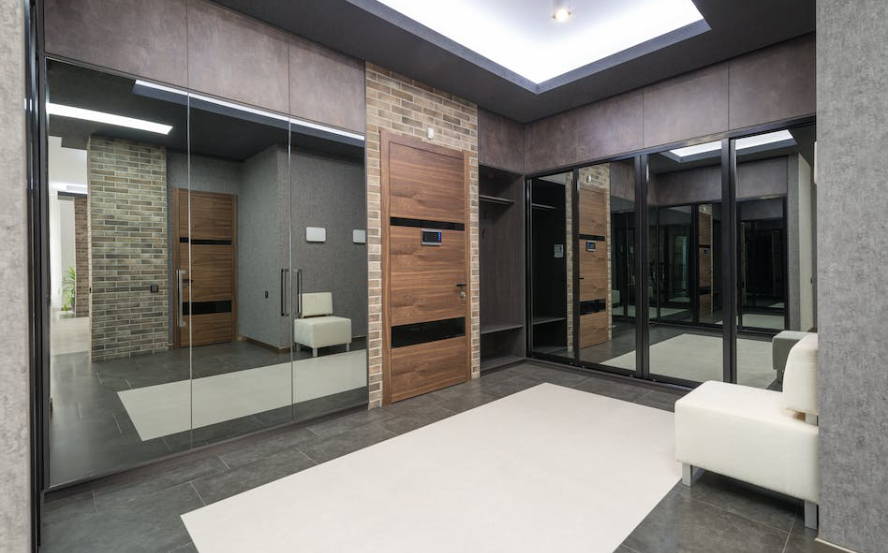Architectural decorative glass has been used in homes and buildings for centuries, providing an attractive, eye-catching aesthetic. It can be used to create windowpanes, doors, and other architectural elements that are both functional and beautiful.

Decorative glass can also be used to create privacy screens or other designs that can add texture and color to a space. There are many different types of decorative glass available which range from stained glass to etched designs.
This type of glass is often associated with traditional architecture but more contemporary styles are also available. With its versatility, architectural decorative glass adds a unique touch to any space while still allowing natural light to filter in.
History of Architectural Decorative Glass
The history of Architectural Decorative Glass is an interesting one, tracing its roots back to the ancient Egyptians and other civilizations. Decorative glass has been used since antiquity to embellish buildings and create unique works of art.
Throughout the years, different cultures have developed their style of architectural glass, from stained glass windows in churches to colorful mosaic tiles in public spaces. Today, architectural decorative glass is still used in modern architecture as a way to add beauty and character to a space.
In ancient Egypt, decorative glass was often used in temple walls and other structures. It was also widely used for decorating vessels such as vases and goblets.
In Rome, it was common for interior walls and doors of private homes to be decorated with colored mosaics made from small pieces of colored marble or stone which were combined with clear or colored pieces of glass.
This technique became popular throughout Europe during the Renaissance period when architects started incorporating it into many public buildings including palaces and cathedrals.
Stained Glass Windows became popular during the Middle Ages when they were incorporated into churches across Europe as a way to beautify their interiors while also telling stories from religious texts through their designs.
Read Also:
Types of Decorative Glass
Decorative glass has been a popular choice for many years, used in everything from windows to furniture and more. Several types of decorative glass can be used to create beautiful and unique designs in any home.
This article will explore the various types of decorative glass that are available so that you can make an informed decision when selecting the perfect type for your project.
Stained Glass:
Stained glass is one of the oldest forms of decorative glass and is still widely used today. It is typically made by painting or staining pieces of colored glass with a chemical solution, which gives it its unique look.
Stained glass can be used to create stunning window designs, as well as other decorative accents such as lamps or chandeliers.
Textured Glass:
Textured glass adds visual interest to any space by creating an irregular surface with small bumps or ridges on its surface.
The raised design gives off a subtle three-dimensional effect that catches the eye, making it increasingly popular among homeowners looking for something unique to add style and character to their home decor.
Manufacturing Processes for Decorative Glass
Decorative glass is a popular choice for many households and businesses looking to create a unique atmosphere. It has been used in everything from home décor to corporate lobbies, and its versatility makes it a great option for many types of spaces.
But how exactly is decorative glass manufactured? Here’s an overview of the different manufacturing processes involved in creating beautiful pieces of decorative glass.
The first step in the process is creating the raw material that will be used to make the decorative glass. This raw material can be anything from recycled or recycled-like glass, such as bottles or windows, or even sand that’s melted down into molten form at high temperatures.
Once this raw material has been created, it undergoes several different treatments and processes depending on what type of decorative glass is being made (e.g., led versus acid-etched).
Leaded glass involves taking pieces of molten lead oxide which are then poured into pre-made molds before being fired at high temperatures in an oven with additional materials like silica sand added for strength.
The result is strong yet lightweight panels with intricate designs created by the design lines left behind by the lead oxide as it cooled down after firing.
Benefits of Decorative Glass in Architecture
Architecture is ever-evolving and constantly incorporates new materials into its designs. One of the most versatile and aesthetically pleasing choices is decorative glass, which has many benefits for architects, designers, and consumers alike.
Decorative glass adds a unique touch of beauty and elegance to any structure. It can be used in a variety of ways, from walls to windows and beyond.
Decorative glass provides an array of options when it comes to color, shape, texture, patterning, and even etching or engraving—allowing architects to create truly one-of-a-kind pieces that are tailored to their client needs. Furthermore, decorative glass can be used both indoors and outdoors with equal success.
In addition to its aesthetic qualities, decorative glass also offers many practical benefits as well.
For instance, it serves as a natural insulator against heat loss in cold climates or when air conditioning is not available in warmer climates by providing an extra layer between the inside and outside environments—reducing energy costs over time for homeowners or businesses alike that utilize this type of architectural element in their design plans.
Considerations When Designing with Decorative Glass
When it comes to interior design, decorative glass can be a great way to add unique style and flair to any space. From stained glass windows to frosted shower doors, there are a variety of ways in which homeowners can incorporate decorative glass into their home decor.
However, several considerations must be taken into account when designing with decorative glass, such as the type of glass used, where the decorative glass will be placed in the home, and how much light will pass through it.
The first consideration is the type of decorative glass that should be used for a particular project. There are several types available, including stained or colored glasses; etched or frosted glasses; leaded or textured glasses; and mirrored or reflective glasses.
The type chosen should fit in with the overall look and feel of the room being decorated as well as provide adequate privacy if desired.
The second consideration is where to place the decorative glass within a home’s layout.
Decorative windows may not fit traditional window frames depending on their size and shape so homeowners must consider whether they will need custom frames made for their project or if existing frames can accommodate them without modification.
Conclusion
Architectural decorative glass is a versatile and aesthetically pleasing material that can be used to add beauty and style to any building. It can create an atmosphere of sophistication and modernity, while also providing a sense of privacy and protection.
With its ability to be customized in terms of color, texture, size, shape, or design, it is an ideal choice for any architectural project.
From traditional designs to contemporary styles, this type of glass can be used in virtually any application imaginable. Decorative architectural glass is sure to make an impressive statement in any space!










